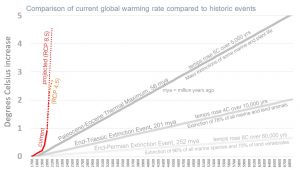Sixth Mass Extinction

The current rate of species extinction is at least 1,000 times greater than the natural background rate, establishing that the sixth mass extinction is underway.[1]
Four out of the five previous mass extinctions in Earth's history were triggered by runaway global heating from greenhouse gas emissions. Currently, carbon gasses are being emitted 10-100x faster than during any previous mass extinction.[2]
Since 1970, 60% of mammal, bird, fish and reptile populations have been killed by human beings.[3]
Freshwater habitats have been the worst hit, with populations collapsed by 83%. South and Central Abya Yala is the worst impacted region so far, experiencing an 89% population collapse primarily due to deforestation. [4]
In 2020, scientists estimated that "the critical window for preventing mass losses will close much sooner than formerly assumed — in 10 to 15 years." Due to non-linear dynamics, the loss of some species "will likely trigger a domino effect that sends others into a downward spiral, ultimately threatening entire ecosystems."[5]
History
Previous Extinctions
Permian Mass Extinction (~250 mya)
Four out of five of Earth's previous mass extinctions were caused by runaway global warming, including the most devastating - the Permian mass extinction 250 million years ago in which an estimated 90% of Earth's species perished. [6] Large emissions of carbon dioxide warmed global temperatures to the point that methane feedback loops were triggered, releasing vast amounts of the gas trapped in permafrost and the ocean seafloor. While the release of carbon dioxide was 'catastrophic,' the release of methane this triggered was 'apocalyptic' and was the 'ultimate source and cause' of the mass extinction. [7]
Triassic-Jurassic Mass Extinction (~200 mya)
The mass extinction event which occurred during the early Jurassic period was also a consequence of rising CO2 levels, which deoxygenated the Ocean (as is currently happening today) leading to mass die-offs of marine life. [8]
Cretaceous Mass Extinction (~65 mya)
CO2 input and environmental changes are currently occurring 12–16× faster than the Cretaceous mass extinction 65 million years ago. [9]
Current Causes
Animals
Mammals
83% of Earth's population of Mammals have been wiped out, with livestock and human beings dominating the remaining population (by biomass) at 60% and 36%, respectively. [10]
Birds
A 2018 global study found that one in eight of known bird species are threatened with extinction, as the "situation is deteriorating and the trends are intensifying.” [11] The study identified agricultural expansion and logging as the two greatest threats to bird species currently, with climate collapse playing a role in nearly a third of imminent extinctions.
Insects
In 2019, the first global study of insect populations found that 40% of insect species are threatened with extinction, while the mass of insects has been declining by 2.5% a year for the last three decades.[12][13]
With 80% of insects already annihilated during this time, scientists warn that the ongoing loss of insects threatens the "catastrophic collapse of nature's ecosystem" and confirms that "the sixth major extinction event is profoundly impacting life forms on our planet."
The study found that the major causes of this collapse are habitat loss via conversion to intensive agriculture, agrichemical pesticides, and climate change.[14] Compliant politicians and policymakers who have fallen prey to lobbying pressure from culpable industries have played a significant role in enabling this catastrophic decline.[15]
Implications
1. General Biodiversity:
Insects are the most diverse group of animals on the planet, include more than a million described species, and represent more than half of all known living organisms. The number of extant species is estimated at between six and ten million, and potentially represent over 90% of the animal life forms on Earth. [16]
2. Ecosystem Support
3. Food Pollination
Fungi
There is increasing evidence that climate collapse threatens fungi as much as plants, animals and other microbes. Pollution, drought, fire and other disturbances all contributing to losses of fungi as well. Yet Mycophobia has led to the extinction threat posed to fungi be drastically understudied. Despite there being more than one million species of fungi, only 551 have been listed as endangered by the International Union for Conservation of Nature's Red List, compared to 25,452 species of plants and 68,054 species of animals (an underrepresentation by a factor of 100x). [17][18]
Yet mycorrhizal fungi can shield endangered plants against extinction, facilitate the dispersal of plants from unsuitable environments, alleviate the effects of abiotic stressors, enable plants to adapt to new climates, and otherwise facilitate their growth. [19]
Fungal symbiosis has empirically played a key role supporting species resilience and collective survival during multiple previous mass extinctions:
Fungi are fundamental to life on earth. They are ancient, they are widespread, and they have formed partnerships with many other species. We know from the fossil record that evolution on this planet has largely been steered by two cataclysmic asteroid impacts. The first was 250 million years ago. The earth became shrouded in dust. Sunlight was cut off, and in the darkness, massive plant communities died. More than 90 percent of species disappeared. And fungi inherited the earth. Organisms that paired with fungi through natural selection were rewarded. Then the skies cleared, and light came back, and evolution continued on its course until 65 million years ago, bam! It happened again. We were hit by another asteroid, and there were more massive extinctions. That’s when the dinosaurs died out. Again, organisms that paired with fungi were rewarded. So these asteroid impacts steered life toward symbiosis with fungi: not just plants and animals, but bacteria and viruses, as well.[20][21]
Sources
- ↑ https://theconversation.com/extinction-is-a-natural-process-but-its-happening-at-1-000-times-the-normal-speed-99191
- ↑ https://thecottonwoodpost.net/2019/12/10/modern-climate-change-is-10x-faster-than-historic-global-warming-mass-extinction-events/
- ↑ https://www.theguardian.com/commentisfree/2019/feb/12/politicians-killing-insects-ecosystems
- ↑ https://www.theguardian.com/environment/2018/oct/30/humanity-wiped-out-animals-since-1970-major-report-finds
- ↑ https://www.nytimes.com/2020/06/01/science/mass-extinctions-are-accelerating-scientists-report.html
- ↑ https://www.independent.co.uk/climate-change/news/earth-permian-mass-extinction-apocalypse-warning-climate-change-frozen-methane-a7648006.html
- ↑ https://www.sciencedirect.com/science/article/abs/pii/S1871174X16300488
- ↑ https://news.fsu.edu/news/science-technology/2018/06/11/volcanic-activity-declining-ocean-oxygen-triggered-mass-extinction-of-ancient-marine-organisms/
- ↑ https://www.sciencedirect.com/science/article/abs/pii/S1342937X17303702
- ↑ https://www.theguardian.com/environment/2018/may/21/human-race-just-001-of-all-life-but-has-destroyed-over-80-of-wild-mammals-study
- ↑ https://www.theguardian.com/environment/2018/apr/23/one-in-eight-birds-is-threatened-with-extinction-global-study-finds
- ↑ https://www.theguardian.com/commentisfree/2019/feb/12/politicians-killing-insects-ecosystems?fbclid=IwAR0vz6jQx3dAe7ApRGv9DTKo7NLSrIH6s1k_DjokvSmW_kVxPslq7mWtDok
- ↑ https://www.theguardian.com/environment/2019/feb/10/plummeting-insect-numbers-threaten-collapse-of-nature
- ↑ https://www.sciencedirect.com/science/article/abs/pii/S0006320718313636
- ↑ https://www.theguardian.com/commentisfree/2019/feb/12/politicians-killing-insects-ecosystems
- ↑ https://untamedscience.com/class/insecta/
- ↑ https://catalystjournal.org/index.php/catalyst/article/view/33523/26712
- ↑ https://theconversation.com/beyond-flora-and-fauna-why-its-time-to-include-fungi-in-global-conservation-goals-181226
- ↑ https://microbiologysociety.org/publication/past-issues/life-on-a-changing-planet/article/impact-of-climate-change-on-fungi.html
- ↑ https://www.edrosenthal.com/the-guru-of-ganja-blog/going-underground-paul-stamets-on-the-vast-intelligent-network-beneath-our-feet
- ↑ see also: https://paulstamets.com/mycological-strategies